Nanotechnologies in Construction: A Scientific Internet-Journal @nanobuild-en
Статьи журнала - Nanotechnologies in Construction: A Scientific Internet-Journal
Все статьи: 572
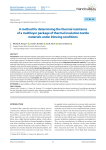
Статья научная
Introduction. Textile industrial materials, particularly in the form of multilayer packages, are extensively utilized as thermal insulation coatings in construction. One of the functional characteristics of these materials is their effective performance under conditions of strong wind exposure. The thermal insulation characteristics of textile thermal insulation materials depend on the value of their air permeability, while minimal thermal resistance is observed from the blowing side. Materials and research methods. The article lists methods that allow for the most accurate calculation of the thermal resistance of multilayer packages consisting of textile building materials under wind-blowing conditions. In this case, the thermal-insulating properties of the materials included in the package will depend on their air permeability. Results and discussion. Our mathematical model used for calculating the thermal resistances of building envelopes, containing thermal insulation packages based on textile materials, includes data on the air permeability of individual layers, as well as on the thickness of their air interlayers. The study presents a scheme of thermal insulation layers that shows temperature curves plotted on it. Stationary medium conditions were used as initial information on temperature distribution between the layers. Further research established that an increase in air velocity of the package affected by the wind influenced the reduction of thermal resistance. Conclusion. The study presents formulas used in determining the thermal resistance of insulating layers and interlayers of building envelopes affected by the wind, under conditions of frontal impact of the air flow, taking into account the established parameters of air permeability of the layers within the package.
Бесплатно
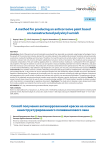
A method for producing an anticorrosive paint based on nanostructured polyvinyl varnish
Статья научная
Introduction. Most of the paint and varnish materials are produced from imported raw materials using foreign technologies. Due to the growth of the construction industry, demand for varnishes and paints has significantly increased. Varnishes and paints provide a protective coating for buildings and structures. Therefore, the need for paint and varnish products made from locally sourced materials is relevant not only in terms of import substitution, but also in terms of economics. The materials used as lacquers are composite compositions. They are made by applying them to a selected surface, resulting in a solid polymer film with appropriate properties. This type of materials is used to coat and protect structural building materials from external influences, and gives them the necessary color and texture. The production of nanostructured anticorrosive paints based on PVC has such advantages as environmental friendliness, high adhesion, high dispersion, low opacity, low viscosity, and environmental resistance. Methods and materials. The scientific research is aimed at obtaining nanostructured lacquer paint by modifying PVC with organic solvents and montmorillonite, a clay mineral of various extraction depths from the Talalaevsky deposit located 20 km from Sterlitamak, Republic of Bashkortostan. The purpose of the scientific work is to use clay minerals consisting of oxides and silicates of aluminum and magnesium with a small content of sodium and calcium salts, which act as nanostructuring binders. The performance characteristics of the obtained nanostructured paint samples were tested for adhesion, opacity, drying rate, and elasticity. Results. The research results have shown that the use of clay as a nanostructuring modifier of PVC paint makes it possible to obtain a product with characteristics corresponding to regulatory documents. Conclusion. This study aims to develop a nano-lacquer paint made from locally available raw materials that can be used to coat building facades and other construction surfaces.
Бесплатно
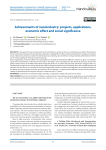
Achievements of nanoindustry: projects, applications, economic effect and social significance
Статья научная
In the paper the review of achievements of nanoindustry is carried out: the use of nanosilica as an additive that improves the fire and thermal resistance of cementitious composites; a welding filler reinforced with nanoparticles for aerospace structures; smart, mobile and autonomous station for collecting and accumulating solar and electric energy; materials authentication with the use of nuclear quadrupole resonance spectroscopy, etc. Areas of application, economic effect and social significance of projects developed in different countries are given. For example, researchers and developers at Ben-Gurion University in the Negev, Israel and Ulyanovsk state technical University, Russia have jointly created a device in the field of alternative energy that allows you to collect and store solar and electric energy for later use. The device has a unique smart system of protection against voltage interruptions and overheating due to the controller devices and software. Also, the device has a number of innovative engineering solutions to reduce the temperature of the heated elements of the device, increase protection from dust and moisture. All this together is a unique solution different from the existing solutions capable of generating and storing solar energy for a long time (up to 10 years).
Бесплатно
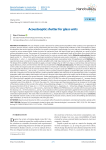
Acoustooptic shutter for glass units
Статья научная
Introduction. The use of liquid crystals is attractive for solving technical problems when creating a new generation of monitors, pressure sensors, seismic activity, determining the level of dry or liquid media, indicators of the concentration of harmful substances due to the small size of devices, low power consumption, simple design, low cost, and easy controllability of liquid crystals by various external fields. Under the action of mechanical shear, the liquid crystal layer is deformed, as a result of which surface polarization occurs. The purpose of the research is to conduct an experimental study of the effect of an electric field on flexopolarization occurring in a thin layer of a liquid crystal to create an acousto-optic shutter. Materials and methods. Nematic liquid crystals 10 – 100 μm thick with homeotropic orientation of molecules were used as materials: n – methoxybenzylidene n – butylaniline; 4 – octyl – 4 – cyanobiphenyl; nitrophenyloctyloxybenzoate; cyanophenyl ester of heptylbenzoic acid. Methods. The experimental setup consisted of a charge-sensitive amplifier with a high input resistance of 10 GΩ and a selective amplifier (2 MΩ). The design of the amplifier made it possible to apply a constant voltage of up to 100 V to its input, as well as linear and synchronous signal detections, which were then fed to the ADC that recorded them. Results and discussion. The behavior of charges induced on the surface of a liquid crystal due to internal mechanisms of molecular-orientation polarization was considered as a function of the magnitude and direction of the external electric field. For this, a liquid-crystal layer (MBBA) was placed in an electric field. The dependences of the first U1ω and second U2ω harmonics, when a positive potential is applied to a deformable plate, reach lower values than with a negative one. The electric field at a positive potential stabilizes the molecules of the polarized layer, and at a negative potential it makes it less stable, which leads in one case to a decrease in the slope angle on the surface, and in the other to an increase, which leads to an increase in the second harmonic. Under weak boundary conditions, a polar deformation occurs in the bulk of the NLC. When the field is applied to the homeotropic layer of NLC (CPEHBA), the value of the second harmonic U2ω increases linearly from the voltage Uc up to the achievement of “saturation”, which is due to an increase in the stabilizing dielectric moment over the viscoelastic one. At low fields (Е ≤ 104 V/cm), the value of U2ω first increases and then decreases due to an increase in the tilt angle of the director relative to the normal to the surface. At low polarizing voltages Uc ≤ 15 V (CPEHBA) dependence U1ω is approximated by a power function of the Uc 3 type, at Uc >> 15 V the second harmonic U2ω depends as Uc –1. At low bias voltages, the position of the minima of the values of the first U1ω and second U2ω harmonics (for MBBA and CPEHBA) does not coincide with the zero point along the abscissa at Uc = 0. The harmonics U1ω and U2ω have a maximum when a positive potential is applied to the moving electrode. In the region of positive displacement voltages, the molecules stabilize, while at negative voltages, the molecules are less resistant to orientational perturbations. The value of the second harmonic U2ω sharply decreases with the perturbation frequency. Conclusion. The obtained research results can be used in the development of pressure sensors, seismic sensors for buildings and structures, light modulators, as well as an acoustooptic switch for glass units.
Бесплатно
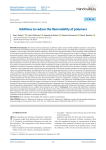
Additives to reduce the flammability of polymers
Статья научная
Introduction. This review article provides data on additives used to reduce the flammability of polymer compositions. It is shown that not individual substances are used for this purpose, but their mixtures, including flame retardants, synergists, and stabilizers. The principle of operation of flame retardants is that when the appropriate degree of concentration of flame retardants in the material is reached, they do not allow it to burn without the presence of an ignition source. Under the influence of fire on the processed material, various chemical and physical processes occur in it, preventing the flame from flaring up. Main part. The advantages and disadvantages of the main flame retardants currently used, which include antimony compounds, halogen-containing compounds, phosphorus-containing substances, as well as aluminum and magnesium hydroxides, are analyzed. Various mechanisms for slowing down combustion processes when flame retardants are used are considered. It has been shown that bromine-containing flame retardants are much more effective than chlorine-containing ones. They decompose in a narrow temperature range. In addition, plastics containing bromine compounds as flame retardants are easily recycled due to the high thermal stability of such flame retardants. Phosphorus-containing compounds have a plasticizing ability and increase the fire resistance of plastic compounds. The action in the condensed phase is that during the decomposition of the flame retardant, phosphoric acid residues are formed, which act as dehydrating agents, contributing to the formation of carbonized structures. In this case, an aerosol can also be formed, which contributes to the deactivation of radicals due to the wall effect. Of particular interest are compounds containing halogen and phosphorus. The advantages of these compounds are as follows: by splitting off halogen radicals during decomposition, they deactivate active radicals; contribute to the formation of carbonized structures. Metal hydroxides decompose under the influence of high temperatures with the release of water. The decomposition reaction is endothermic, resulting in cooling of the substrate to temperatures below the flash point. The formation of water contributes to the dilution of combustible gases released during decomposition, weakens the effect of oxygen and reduces the rate of combustion. The effectiveness of hydroxides is directly proportional to their content in the polymer. The greatest efficiency is observed when aluminum hydroxide is introduced into oxygencontaining polymers (polyethylene terephthalate, polybutylene terephthalate, polyamide). Magnesium hydroxide is more expensive than aluminum hydroxide, but has a higher heat resistance (up to 300оC). Conclusion. Thus, among the listed flame retardants, aluminum and magnesium hydroxides occupy the first place in terms of the volume of use (more than 40% of the total volume of flame retardants). This is due to their low cost, manufacturability of their application and environmental safety. A well-chosen metal hydroxide system produces a low-cost non-combustible material with little fumes from decomposition. Therefore, the use of metal hydroxides as flame retardants is constantly increasing.
Бесплатно
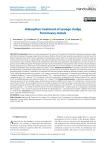
Adsorption treatment of sewage sludge from heavy metals
Статья научная
Introduction. Because of urban development the volume of municipal and industrial wastewater are growing. Along with them the amount of sewage sludge (SS) also increases. Millions of tons of SS are currently accumulated on the territory of the Russian Federation and contain various pollutants, including heavy metals (HM). In this regard, the search for effective methods of SS treatment from HM is an urgent problem. The main methods of SS treatment are drying, dehydration, thermal methods, UV and microwave wave treatment. These kinds of disinfection eliminates many pathogenic microorganisms, but they are quite expensive and not effective against HM. Reagent methods include SS disinfection with quicklime (CaO). However, decontamination requires large doses (up to 30%) and it is also ineffective against HM. Humic-mineral reagent are more effective, they are based on crushed caustobiolites, their cleaning capacity from HM is 19–87%. Methods and materials. The authors have previously shown the effectiveness of wastewater treatment from HM using sorbents based on dolomite, quartzite, and waste from mining and processing plants. Therefore, a method for SS treatment from HM using sorbents based on dolomite, humates, and CS containing CaCO3 and humic compounds was proposed. In this regard, a method was proposed for SS treatment from HM using three types of sorbents based on: 1) waste of thermal power plants (TPP) – conditioned sludge (CS) containing CaCO3 up to 68% and humic compounds up to 12% – sorbent 1 (S1); 2) dolomite – Mg and Ca carbonate in a composition with sodium humate (25%)– sorbent 2 (S2); 3) modified dolomite with sodium humate (1%) – sorbent 3 (S3). Results and discussion. In laboratory experiments, the cleaning capacity of SS was studied using a dolomite-based sorbent modified with humate (1%). In field tests, a decrease in the concentration of HM in SS was studied with the use of sorbents based on CS and the complex sorbent dolomite-humate (75:25). The cleaning capacity of SS from HM increases in the series: sorbents based on waste from TPP – CS containing CaCO3 and humates (cleaning capacity E = 4.8–48.6% for dried SS and 29.3–53.3% for dehydrated SS) < sorbent based on a composition of dolomite with humate (E = 65.1–92.1% for dried and 56.6–89.4% for dehydrated SS) < a dolomite-based sorbent modified with humate (E = 90.8–99.9%). Conclusions. The maximum cleaning capacity is shown by a dolomite-based sorbent coated with a nano- and micro- sized layer of sodium humate.
Бесплатно
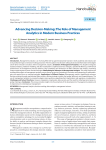
Advancing Decision-Making: The Role of Management Analytics in Modern Business Practices
Статья научная
Introduction. Management analytics is an evolving field that has gained substantial traction in both academia and industry due to its profound impact on decision-making processes. The inte-gration into decision making of advanced information technologies and AI drive innovative solutions within management analytics. Evolution of Management Analytics. The discipline integrates statistical analysis, predictive modeling, and data visualization to optimize business strategies, operational efficiency, and financial performance. As management practices advance, they contribute new dimensions to data collection and analysis, presenting unique opportunities to boost nanotechnologies. Methodological Advances in Management Analytics. This study explores the transformative effects of management analytics across diverse sectors by illustrating its evolution and interpreting its methodologies with special focus on nanotechnologies. Applications in Different Sectors. Management analytics significantly enhances decision-making through sophisticated data analysis, offering strategic insights that propel efficiency and competitiveness. The use of management analytics in nanotechnologies raises questions regarding ethical implications and regulatory considerations. Challenges and Future Directions. However, integration complexities, data security, and the need for skilled personnel pose ongoing challenges. Conclusion. This review provides insights into the potentials of the development of management analytics and its importance in contemporary management.
Бесплатно
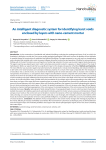
Статья научная
Introduction. In the construction of residential and industrial buildings, analyzing the underground layers of soil on which the foundation is built plays a crucial role. Due to poor-quality geological exploration of the earth's surface, the problem of karst sinkholes is revealed during the construction of residential and industrial buildings. The paper proposes to carry out work on strengthening water-saturated and unstable soils in order to prevent collapse during the construction and operation of facilities for various purposes. Drilling wells in the karst formation zone and injection of reinforcing material is the main way to protect against karst phenomena. The paper examines gas-liquid layers (karst voids) containing nanocrystals located in a gaseous or liquid medium. The study of hydrodynamic fields is an urgent task that has a significant impact on the design and operation of facilities. Methods and materials. The most effective way to protect against karst phenomena for already built or newly erected buildings and industrial facilities is to drill wells in the karst formation zone and inject reinforcing material. As a result of the study conducted after the introduction of nanosilicon into a cement mortar, it is found that the hardening time of cement decreases with an increase in the number of nanoparticles of nanosilicon, i.e. nanoparticles have a higher rate of hydration reaction compared with cement. When a reinforcing material in the form of nanosilicon with cement mortar is introduced into the rock thickness of the karst formation zone, forming a lower insulating and upper stabilizing layer that prevent water access to the karst at the depth of the karst rock and stabilize the surface. At the karst formation stage, located within the boundaries of the collapse prism and corresponding to the width of the lower layer, two layers of the upper and lower supporting layer are created. Groundwater flow channels from catchments to discharge zones are formed between rock-thick support layers and insulating stabilizers that support the natural hydrogeological regime of the rock strata containing karst water layers. As a result, the protective properties of the rock increase when signs of karst appear, the physico-chemical and bearing properties of the soil improve, the strength properties of the soil increase and the likelihood of landslides decreases. Results. Hydrodynamic fields during filtration of nanogasated liquids in karst voids have been theoretically studied. Discussions. By installing a permanent automated monitoring system for motion sensors, pressure and temperature of liquid and gas in karst voids on the control well, we will be able to monitor the dynamics of the main hydrodynamic parameters of karst voids, allowing us to assess the current regime of karst voids and, in case of danger, alert emergency services and residents of the house. By monitoring the operation of sensors using artificial intelligence, it is possible to predict the occurrence and development of critical situations. Conclusion. The addition of silica nanoparticles to the cement mortar changes the rheological properties of the mortar, affecting its viscosity and fluidity. Groundwater flow channels from catchments to discharge zones are formed between rock-thick support layers and insulating stabilizers that support the natural hydrogeological regime of the rock strata containing karst water layers.
Бесплатно
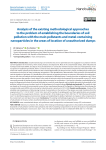
Статья научная
Introduction. Unauthorized dumps are territories that are not permitted and not equipped in accordance with the current legislation of the territory, where waste products are disposed of. Most of the unauthorized dumps, both industrial and municipal solid waste (MSW), are objects of accumulated harm. In connection with the increase in the use of nanoparticles of various genesis in engineering materials, there is a need to assess their impact on environmental components and human health. One of the main marker substances that determine the ecotoxicological effect of dumps are heavy metals, including those entering the environment in the form of metal-containing nanoparticles. Their identification, determination of the processes of horizontal and vertical migration of pollutants (P), identification of the intensity of negative processes are necessary information for making decisions on the choice of methods and technologies for recultivation of disturbed areas. Currently, there are no legislative acts (LA) that take into account the specifics of such objects in the study of territories within the framework of environmental surveys (ES), which necessarily precede the implementation of project documentation for recultivation. A vital task is to develop a methodological approach to diagnosing the state of territories disturbed as a result of waste disposal, and to reliably determine the boundaries of soil pollution, taking into account modern trends in the development of nanotechnology. Methods and materials. The analytical study was based on the results of environmental surveys at four unauthorized dumps of the Republic of Bashkortostan (three dumps for municipal solid waste (MSW) and one dump for industrial waste), carried out in 2019–2020. Results and discussion. A study of the reliability and completeness of determining the level of soil pollution in the territory of the dumps was made. Deviations from the requirements of СS 11-102-97, GOST 17.4.3.01-83 in terms of the number of sampling points and their spatial location were revealed. It was found that the requirements of Article 1 and Article 80.1 of the Federal Law of 10.01.2001 No.7-FL “On Protection of Environment” on identifying negative environmental changes and establishing the ability of pollutants to migrate to other components of the environment were not taken into account. Conclusions. The existing methodological approaches to establishing the boundaries of soil pollution in the areas where unauthorized dumps are located require revision and specification.
Бесплатно
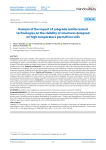
Статья научная
Introduction. Ensuring the stability of the subgrade in areas with permafrost soils is one of the most pressing challenges in modern design, construction, and operation of transportation infrastructure. In the context of global climate change and increasing anthropogenic loads on soil foundations, the search for effective ground reinforcement technologies has become a key area of research. This article presents an analysis of the impact of reinforcement technologies for high-temperature permafrost soils on the stability of structures. Methods and Materials. Two structural and technological solutions for reinforcing the foundation soils of the subgrade are considered: the use of jet grouting technology and the installation of vertical crushed stone columns. The study is based on numerical modeling of the stress-strain state of the subgrade on permafrost soils, both with and without the proposed structural and technological solutions. Results and Discussion. A comparative analysis of vertical displacements, shear deformations, and slope stability factors was performed for each technology. Overall, the proposed foundation soil reinforcement technologies improve the reliability of structures built on them, particularly the subgrade. The choice of foundation soil reinforcement technology should be based on an analysis of specific construction and operational conditions of the object – natural, technical, technological, and economic factors. Conclusion. It can be noted that in similar engineering-geological conditions, as described in this study, jet grouting is suitable for reinforcing foundation soils in areas with high stability and bearing capacity requirements, but with mandatory preliminary selection of the cement slurry and analysis of its exothermic behavior during strength gain. Vertical crushed stone columns, as a method of soil reinforcement, represent a promising structural and technological solution, especially for less heavily loaded sections.
Бесплатно

Anatase-silica additive for self-cleaning materials based on cement
Статья научная
Introduction. The cost of anatase additives to concrete can be lowered by synthesizing it and applying it to a mineral substrate that is active against cement. In particular, the use of anatase in mineral powders such as silica shows promise. This paper describes the synthesis of anatase-silica photocatalysts with varying anatase to silica ratios and evaluates their performance in cement-based materials. Materials and methods. The photocatalytic additive was obtained by TiO2 deposition on the microsilica substrate using sol-gel technology. The physicochemical studies included X-ray phase analysis and electron scanning microscopy. To determine the self-cleaning, we used the rhodamine test. Results and discussion. An increase in the TiO2/SiO2 ratio increases the area covered with anatase and the height of the main anatase reflections in the X-ray phase analysis. But the increase in the anatase reflection intensity is not proportional to the change in the TiO2/SiO2 ratio with the same size of anatase crystallites. With an increase in TiO2 relative to SiO2, the self-cleaning efficiency increases and reaches the required level when the ratio of oxides in the additive is slightly less than 1:1. It means that 1 g of TiO2 is enough per specific surface area of the substrate 22 m2 to create an effective photocatalytic additive. Conclusion. The optimal TiO2/SiO2 ratio of 1:1 was revealed by varying the amount of anatase relative to the substrate in the range of TiO2/SiO2 ratios from 1:2 to 1:0.5. The results can be used in the production of technically and economically effective photocatalytic additives for self-cleaning materials based on cement.
Бесплатно
Anti-icing coating based on silicone resin SILRES® MSE100
Статья научная
Introduction. The study is aimed at obtaining an anti-icing coating for building structures by creating a hydrophobic surface layer, which is regulated by surface energy and surface topography. Materials and methods. Acrylic resins A-01 and DEGALAN®, high-chlorinated polyethylene resin HCPE and silicone resin SILRES® MSE 100 were used in the research. Aerosil R 972 nanoparticles were used as a filler. The anti-icing properties of the coating were evaluated by the contact angle of the water drop with the coating, the static and dynamic contact angle, the wetting hysteresis, and the adhesion of ice to the superhydrophobic surface. Results and discussions. We have found that coatings based on acrylic resins A-01, DEGALAN®, high chlorinated polyethylene resin HCPE and silicone resin SILRES® MSE100 20% concentration do not provide superhydrophobic properties. The superhydrophobic effect is retained by coatings based on SILRES® MSE100 silicone resin 5% and 10% concentration. The force of detachment of a drop from a coating based on SILRES® MSE100 silicone resin at a 10% concentration is 3 times less, which ensures an easier rolling of a water drop from the surface and its anti-icing properties. The amount of ice on an untreated surface is 0.59 kg/m2, and on a surface treated with a composition based on SILRES® MSE100 silicone resin, it is 0.15 kg/m2. Conclusions. An anti-icing coating composition based on SILRES® MSE100 silicone resin has been developed. The proposed composition forms a coating characterized by anti-icing properties that remain in operation.
Бесплатно
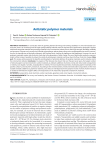
Статья научная
Introduction. In connection with the growing demand for living and working conditions in civil and industrial construction, there is an increasing need for high-quality building materials with the required set of performance properties. Polymer reinforced composite materials are promising materials in the construction industry due to their high strength, durability, reliability and economy. Polymers such as polyvinyl chloride, polyurethanes, polyacrylates, epoxy resins, polypropylene are used in construction for the manufacture of decorative elements, self-leveling floors, coatings for appliances and equipment. However, the use of polymeric materials creates risks of electric shock due to the generation of static charge. The use of electrically conductive nanomaterials as fillers makes it possible to reduce the resistivity of polymeric materials and slow down the flow of electric charges. Main part. This review article presents the benefits and drawbacks of antistatic additives for polymer materials used in industry and in the construction industry. Conclusion. An analysis of the literature has shown that over the past seven years, the largest number of relevant papers has been devoted to carbon materials as antistatic additives (8 articles), metal and metal oxide nanoparticles (7 articles), ionic liquids (7 articles), and polyaniline (7 articles). The most studied characteristics of antistatic polymer materials are the specific surface RS and volume RV resistances. According to the reviewed articles, metal and metal oxide nanoparticles are the most suitable antistatic additives to polymeric materials, since they are well dispersed in the polymer matrix. However, further research is needed to eliminate the negative effect of nanoparticles on the mechanical properties of polymeric materials.
Бесплатно
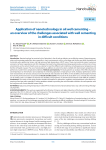
Статья научная
Introduction. Nanotechnology has received a lot of attention in the oil and gas industry as an effective means of improving properties and increasing production rates, especially in harsh environments such as ultra-deep and shallow gas fields, deviated and horizontal wells, geothermal zones, and high pressure/high temperature (HPHT) areas. These environments present numerous economic, technical, operational, and HSE challenges that need to be addressed.Cementing operations play a critical role in these environments, as the cement sheath serves as a barrier to meet the different well conditions, including pressure, temperature, and the flow of liquids or gases. The use of nanomaterials as additives to cement has been credited with improving its properties and performance under these complicated conditions. Methods and materials. The study presents an analysis of the effect of pressure and temperature on the behavior and complexity of cementing operations in high-pressure wells. Analytical performance of the main characteristics of nanoclay (structural and mechanical) and evaluation of its effect on the durability and strength of cement slurry during well construction are presented. Results and Discussion. The results of the study allow us to conclude that nanoclay can be widely used as an additive to improve the durability and properties of cement-based materials under difficult conditions. Conclusions. The results of this study provide valuable information to researchers, engineers and practitioners in the field of cementing oil and gas wells, especially in solving problems related to providing the most favorable conditions for well operation with the long-term use of more durable cement slurry.
Бесплатно







